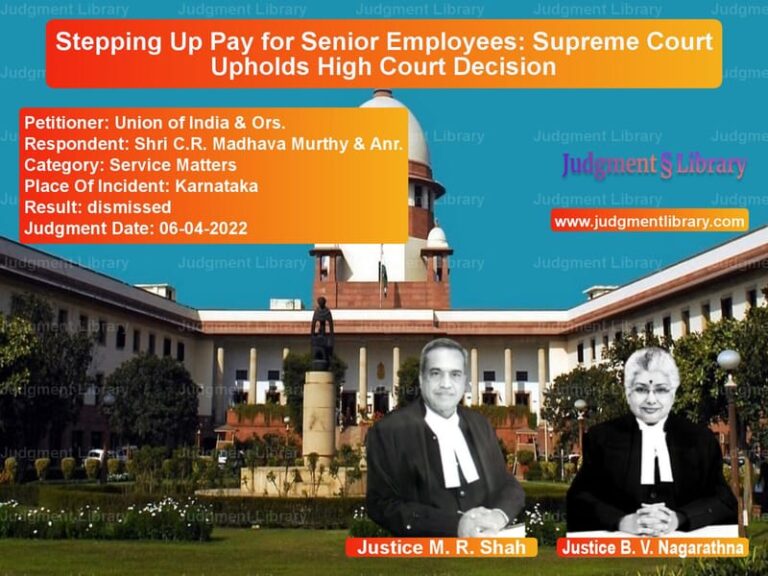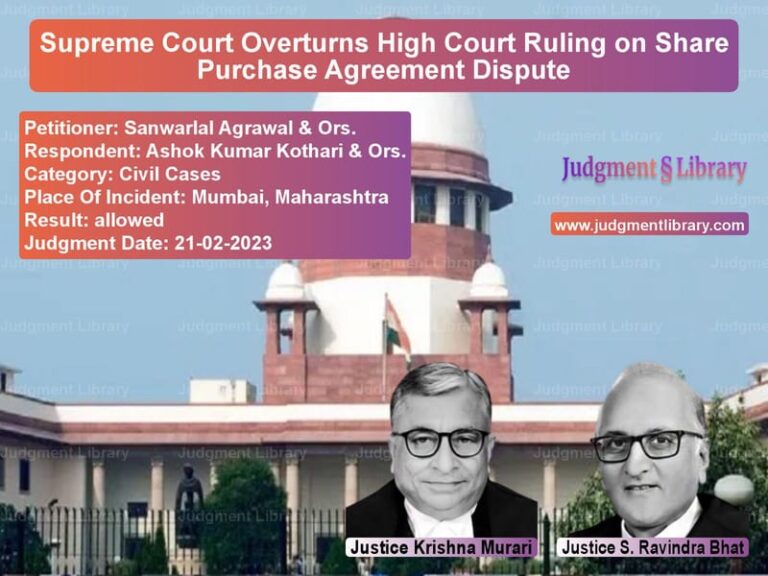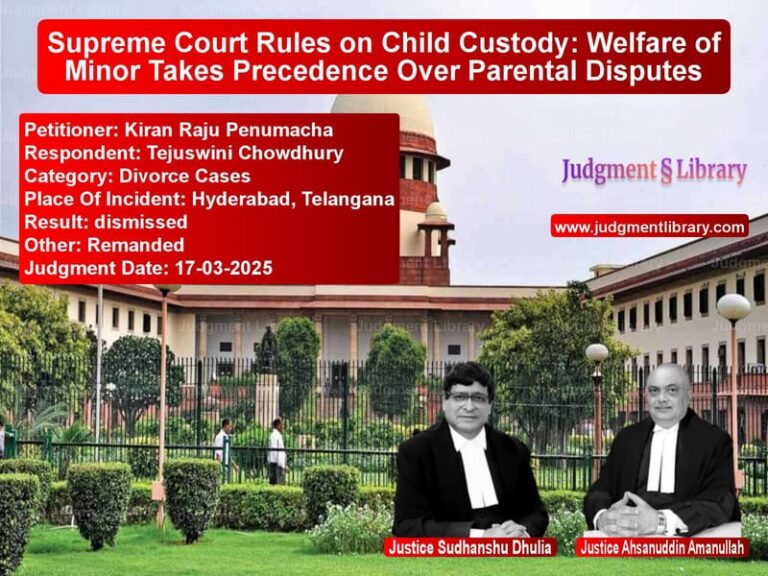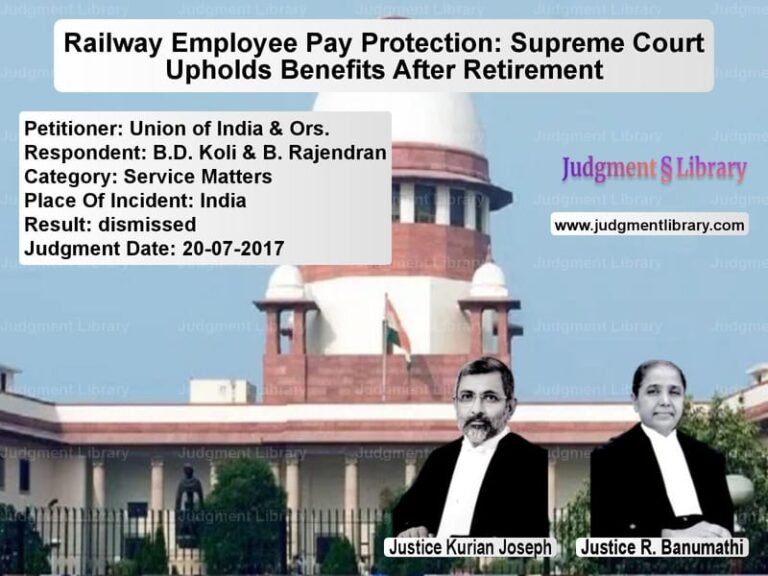Supreme Court Upholds Conviction in Murder Case: Circumstantial Evidence and Burden of Proof
The Supreme Court of India, in its judgment dated August 22, 2019, in the case of Sudru v. The State of Chhattisgarh, examined the principles of circumstantial evidence in a murder trial. The case revolved around the death of the appellant’s son, Ajit, and whether the appellant was rightly convicted under Section 302 of the Indian Penal Code (IPC). The Court upheld the conviction based on the doctrine of circumstantial evidence and the principle of burden of proof under Section 106 of the Indian Evidence Act.
Background of the Case
The case originated from a tragic incident on July 23, 2000, in Bastar, Chhattisgarh. The appellant, Sudru, was accused of murdering his own son, Ajit. On the previous night, Sudru had returned home in an inebriated state and had a quarrel with his wife, Janki Bai. In response, Janki Bai left the house with two of their children and spent the night at her brother-in-law’s house, leaving Ajit behind with his father.
The next morning, when Janki Bai returned, she found Ajit lying on a mat, covered with a blanket. Upon removing the blanket, she discovered that he was dead, with blood oozing from his mouth. Injuries were also visible on his neck. Janki Bai immediately informed her father-in-law, and an FIR was lodged at the Dantewada police station.
The case was investigated, and Sudru was arrested and charged with murder under Section 302 of the IPC. The prosecution relied on circumstantial evidence since there were no eyewitnesses to the crime. The Trial Court convicted Sudru, sentencing him to life imprisonment and imposing a fine. The conviction was upheld by the Chhattisgarh High Court. Aggrieved, Sudru appealed to the Supreme Court.
Petitioner’s Arguments
The appellant’s counsel argued:
- Lack of direct evidence: The case was entirely based on circumstantial evidence, and no witness had seen the appellant committing the crime.
- Hostile witnesses: Janki Bai, the deceased’s mother, turned hostile and did not fully support the prosecution’s version.
- Failure to establish the chain of events: The prosecution failed to establish a continuous chain of circumstances leading to the inevitable conclusion of guilt.
- Alternative explanation: The appellant claimed that Ajit died due to an illness, not due to homicidal assault.
Respondent’s Arguments
The prosecution, representing the State of Chhattisgarh, argued:
- Last seen theory: The deceased was last seen alive with the appellant, and the appellant had the opportunity to commit the crime.
- Injuries indicating strangulation: Medical evidence confirmed that Ajit suffered injuries consistent with strangulation, ruling out a natural cause of death.
- False explanation under Section 313 Cr.P.C.: The appellant’s claim that Ajit died of illness was contradicted by medical findings.
- Failure to explain the circumstances: The burden shifted to the appellant to explain what happened during the night, as per Section 106 of the Indian Evidence Act.
Supreme Court’s Observations
The Supreme Court analyzed the legal aspects of circumstantial evidence and made the following key observations:
1. Circumstantial Evidence Must Form a Complete Chain
The Court reiterated that in cases based on circumstantial evidence, the prosecution must establish a complete chain of events that lead to the sole conclusion of the accused’s guilt.
“In a case based on circumstantial evidence, the prosecution must establish a chain so complete that it rules out every other hypothesis except the guilt of the accused.”
2. Application of Section 106 of the Indian Evidence Act
The Court observed that once the prosecution establishes that the deceased was last seen with the accused, the burden shifts to the accused to explain the circumstances of death.
“When a person was last seen with the deceased, and the deceased was later found dead, the accused must explain how the death occurred.”
3. Role of Hostile Witnesses
Despite Janki Bai turning hostile, the Court emphasized that her testimony could be relied upon to the extent that it was credible.
“A hostile witness’s evidence does not become inadmissible. It can be used to the extent it supports the prosecution’s case.”
4. Medical Evidence as Corroboration
The medical report confirmed that the deceased had suffered fractures and strangulation marks. The Court ruled that medical findings reinforced the prosecution’s case.
“The medical evidence corroborates the case that the death was homicidal and not due to natural causes.”
Final Verdict
The Supreme Court dismissed the appeal and upheld the conviction, stating:
- The appellant’s presence with the deceased was established.
- The injuries on the deceased’s body indicated strangulation.
- The appellant failed to provide a reasonable explanation for the death.
- The chain of circumstantial evidence was complete and conclusive.
Impact of the Judgment
This ruling has significant implications for criminal law:
- Strengthening the Last Seen Theory: The verdict reaffirms that an accused must explain the circumstances if they were last seen with the deceased.
- Role of Hostile Witnesses: Courts can rely on portions of testimony from witnesses who turn hostile.
- Medical Evidence as Crucial Proof: Post-mortem findings play a decisive role in proving homicide.
Conclusion
The Supreme Court’s judgment in Sudru v. State of Chhattisgarh is a landmark ruling on circumstantial evidence and burden of proof. By upholding the conviction, the Court emphasized the importance of an accused explaining the circumstances when last seen with a deceased person. The ruling provides clarity on evidentiary standards in criminal cases, ensuring that justice is served based on a thorough and logical evaluation of facts.
Petitioner Name: Sudru.Respondent Name: The State of Chhattisgarh.Judgment By: Justice Deepak Gupta, Justice B.R. Gavai.Place Of Incident: Chhattisgarh.Judgment Date: 22-08-2019.
Don’t miss out on the full details! Download the complete judgment in PDF format below and gain valuable insights instantly!
Download Judgment: Sudru vs The State of Chhatti Supreme Court of India Judgment Dated 22-08-2019.pdf
Direct Downlaod Judgment: Direct downlaod this Judgment
See all petitions in Murder Cases
See all petitions in Bail and Anticipatory Bail
See all petitions in Attempt to Murder Cases
See all petitions in Judgment by Deepak Gupta
See all petitions in Judgment by B R Gavai
See all petitions in dismissed
See all petitions in supreme court of India judgments August 2019
See all petitions in 2019 judgments
See all posts in Criminal Cases Category
See all allowed petitions in Criminal Cases Category
See all Dismissed petitions in Criminal Cases Category
See all partially allowed petitions in Criminal Cases Category







